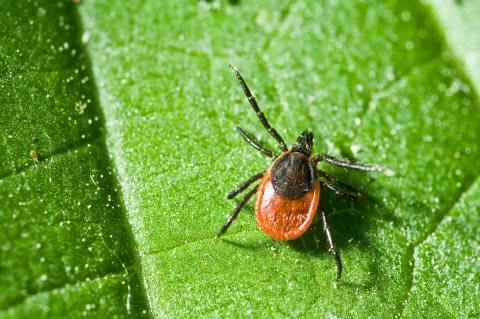Borrelia miyamotoi: About
Borrelia miyamotoi is a species of bacteria spread by ticks that can cause human illness in Wisconsin, although this is rare. It is spread by the deer tick, also known as the black-legged tick.
B. miyamotoi infections are most common in the Upper Midwest (including Wisconsin), the Northeast, and the mid-Atlantic states, in places where Lyme disease is common. The bacteria are most likely to be spread in July and August.
Anyone can get B. miyamotoi, but people who spend more time outdoors are at higher risk of being bitten by an infected tick. Ticks can be found in areas with woods, brush, or tall grass. Ticks are most active from May to September, but it is important to use caution year-round to prevent tick bites.
B. miyamotoi is spread to humans through the bite of an infected deer tick.
- A tick can spread B. miyamotoi within the first 24 hours of being attached to a human. It is important to remove ticks as soon as they are found to prevent illness.
- Most humans are infected by immature ticks, called nymphs.
- Nymphs are very small, about the size of a poppy seed. They are difficult to see, and most people may not feel their bite. This makes them harder to remove promptly.
- Nymphs are most active during the spring and summer.
- Adult ticks also spread B. miyamotoi.
- Adults are much larger than nymphs, and are more likely to be found and removed before the bacteria are spread to the person.
- Adult ticks are most active during the cooler months.
- B. miyamotoi may be spread by larval ticks.
- Larval ticks are even smaller than nymphs and are very unlikely to be noticed.
- Larval ticks are most active in summer and fall.
- Ticks can attach to any part of the body but are often found in hard-to-see areas, such as:
- Behind the knees
- Armpits
- Scalp
- In and around the ears
- Inside the belly button
- Groin
B. miyamotoi is preventable and treatable. Visit our Tick Bite Prevention page to learn how to prevent tick bites, and how to properly remove a tick if you are bitten.
Symptoms can show up days to weeks after being bitten by an infected tick.
Common signs and symptoms:
- Fever
- Chills
- Fatigue
- Severe headache
- Muscle aches
- Joint pain
B. miyamotoi can be successfully treated with the antibiotics and dosages used to treat Lyme disease. It is important to get treatment as soon as possible after symptoms start. Antibiotics commonly used for oral treatment include doxycycline, cefuroxime axetil, or amoxicillin. The following table shows the current treatment recommendations from the Centers for Disease Control and Prevention (CDC) for early stage Lyme disease in adults and children.
DHS Resources
- Tickborne Diseases Risk in Wisconsin, P-01751 (PDF): Educational flyer describing the risk posed by illnesses spread by ticks in Wisconsin.
- Tick Safety Guide Tri-Fold Card, P-01434 (PDF): Educational tri-fold card covering ticks in Wisconsin, proper tick removal, and tick bite prevention.
- Protecting Your Family from Mosquitoes and Ticks, P-02080 (PDF): A fact sheet with simple steps you can take to protect yourself from ticks.
CDC Resources
- Preventing Ticks on Your Pets: Information on ticks and your pets.
- It's Open Season on Ticks: A fact sheet on tick bite prevention for hunters.
- CDC Trail Sign: Plastic trail sign used to remind hikers that there are ticks in the area and how to prevent bites. Available for order from CDC.
- Lyme Disease Prevention and Tick Removal Bookmark: A bookmark with information on how to properly remove a tick. Available for order from CDC.
- Don't Let a Tick Make You Sick Comic: An educational comic for kids about preventing illnesses spread by ticks.
- Don't Let a Tick Make You Sick Crossword: An educational crossword for kids about preventing illnesses spread by ticks.
Partner Resources
- Wisconsin Ticks and Tick-borne Diseases: Information on ticks and diseases they spread from our partners at the University of Wisconsin-Madison Medical Entomology Laboratory.
- Midwest Center of Excellence for Vector-borne Disease Ticks: Information on ticks found in the Midwest, tick surveillance resources, and tick biology and development.
B. miyamotoi is preventable and treatable. Visit our Tick Bite Prevention page to learn how to protect yourself from illnesses spread by ticks.
Questions about illnesses spread by ticks? Contact us!
Phone: 608-267-9003 | Fax: 608-261-4976




